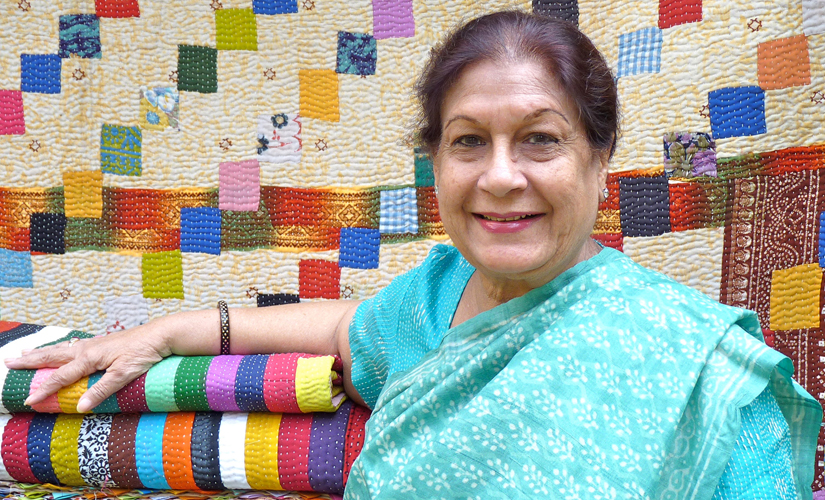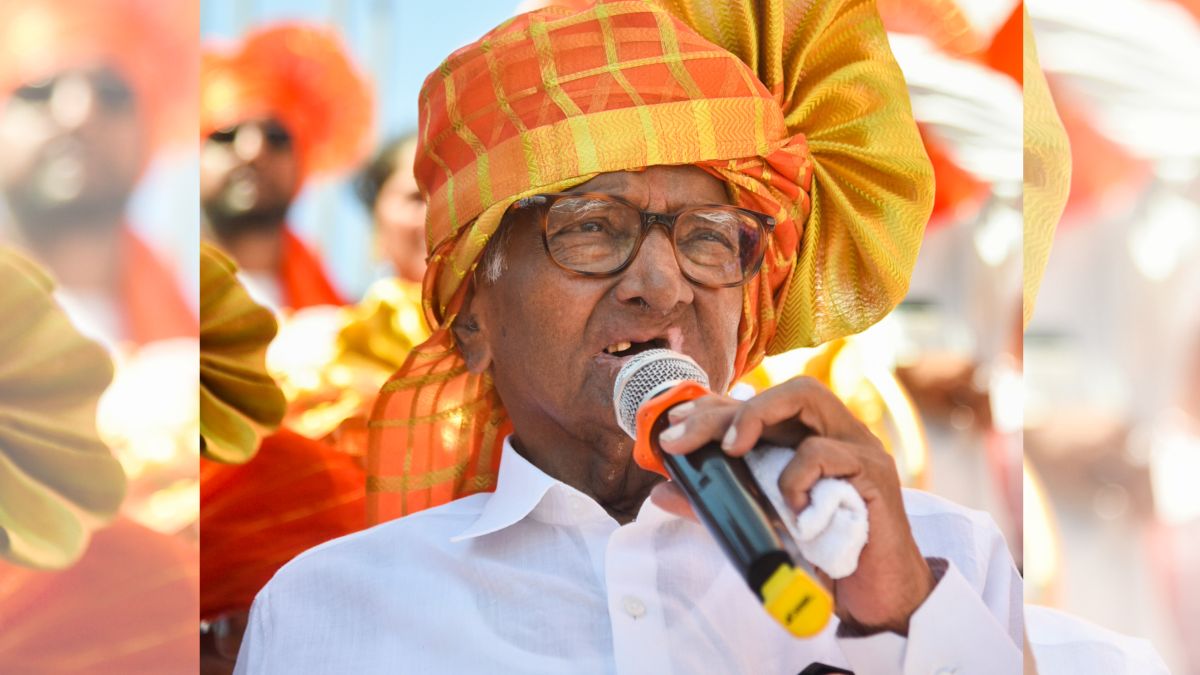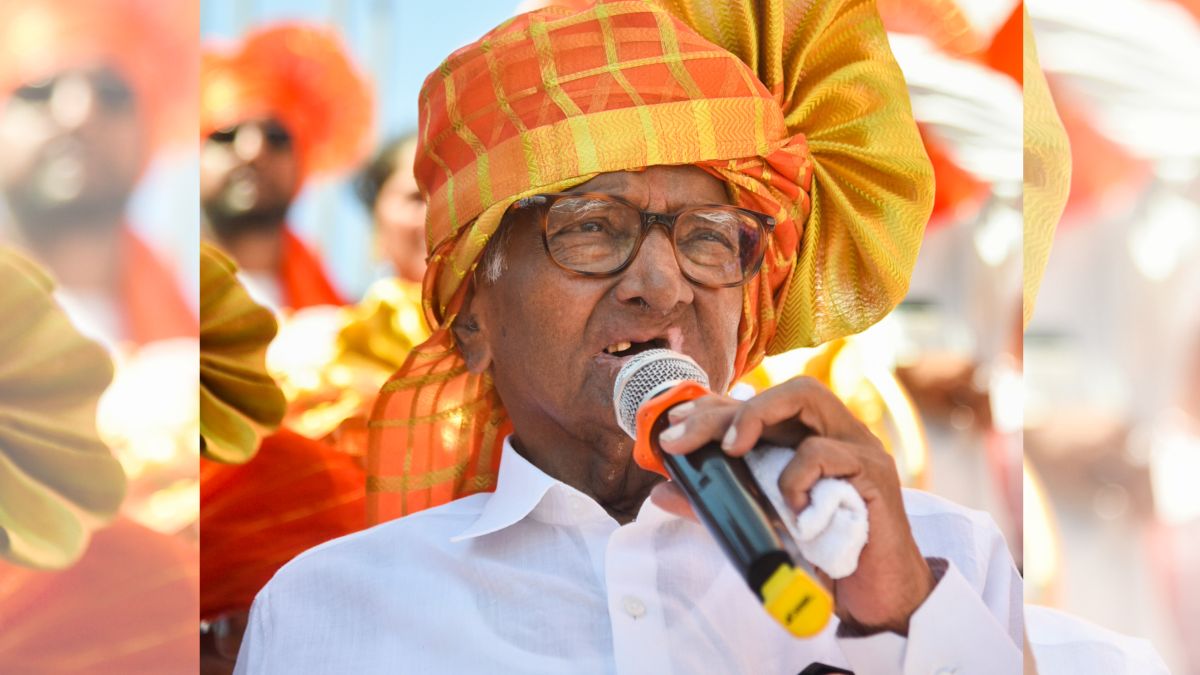It is a multi coloured quilt that you’d see hanging out occasionally on walls in slums or roofs or on shacks on the roadside. Godhari — a quilt stitched with old clothes and fabrics – is a patchwork of bright coloured clothes that is sewn by women in households. Traditionally made with a thick thread, it is also machine stitched (perils of modernity) by enterprising women today.
Geeta Khandelwal, author of Godharis of Maharashtra, Western India. Image courtesy: Godharis of Maharashtra, Western India
_Godhari_s are something that most of us take for granted. It is made from old weathered saris randomly placed layer upon layer sometimes as many as six layers at a time. In between each layer, the quilter adds fillers– most often used trousers or shirts that have been ripped open and laid out flat. The multiple layers are bound together with the standard running stitch, for which thick heavy cotton thread is used. The quilting pattern consists of straight parallel lines running through the length of the godhari. The quilt is used as a blanket in cold climse. To see it being elevated in a book with exhaustive details–about how it is made, fabrics used, designs and the meticulousness of the craft – begs the question, Why?
When one flips through the coffee table tome, Godharis of Maharashtra, Western India by Geeta Khandelwal priced at a hefty Rs 3,400 and speaks with the author, one understands why.
Khandelwal, a skilled needle work person, has been passionate about working on cloth since she was six. “That’s as early as I can remember,” she says. “My romance with fabric started at an early age, when I sewed my own clothes. I learnt to appreciate textures of different fabrics, to discern the colours, sheen and weight of the cloth (pieces). This has led to a life-long journey of exploring and interacting with the rich world of Indian textiles.”
Khandelwal has been in the business of quilts since the ’70s. She started learning how to make quilts based on American designs, which is how she met Linda Schaepper, an American who was putting together a sampling of locally manufactured quilts of American design for the western market. Soon Khandelwal developed her own vast storehouse of quilts which exported to the European and US markets, a business which ran for 30 years.
Her journey into Maharashtra’s unique _godhari_s was a deliberate attempt to see for herself and record the work done by rural women. Being familiar with Lonavla, the holiday spot that she frequented with her family since school days, Khandelwal began her journey from here. “There was no documentation available to guide us in our search,” she says, adding that she hopes the book inspires researchers on the subject of quilts to study it in greater detail.
The first thing that Khandelwal and her team spotted on a curve on the road in Kamshet, on the outskirts of Lonavala as they undertook their trip was a godhari drying in the sun. Her enthusiasm as she recalls the incident is palpable. The reaction of the lady, Subhadhra, whose quilt it was, was one of suspicion. “She was surprised and a bit suspicious when asked if she made _godhari_s and would she show it to us? It was the first time someone had asked her,” says Khandelwal smiling at the memory. Subhadhra needed a little bit of coaxing and explanation before she agreed to show the quilt made with pieces of coloured cotton materials cut from old blouses.
The book has _godhari_s in patterns rarely seen and traditions that are not heard of. There are some interesting nuggets of information such as: The _godhari_s of Jalochi have designs that give off a step well effect felt and makes the viewer feel he/she is peering into one. Or that fortune tellers known as Nandibailwale use new pieces of cloth to make _jhulai_s or coverings for _nandibail_s or bulls. Some mothers make _godhari_s for their children using the swastika and a red dot to ward off the evil eye. The ones made by Muslim women in the Konkan region are made from bright, new cloth pieces and are given as gifts during weddings, births or other ceremonial events.
An interesting tradition that Khandelwal noticed was from the interiors of Kolhapur where the villagers stitch the _godhari_s from the outer edges towards the centre, unlike the accepted pattern of stitching it in reverse order in other parts of Maharashtra. Called vakal, when it is nearing completion, a slit-like pocket is made in the centre called the poat or stomach which is then filled with dried bhakri, kum kum, turmeric power and some rice grains. Then, a ritual is performed on a Thursday with a prayer to the family Goddess beseeching for `filled stomachs’ or meals for the family.
The making of a godhari is a long-drawn process and can take up to at least three months to finish one. They are made purely for functional and personal use as blankets, floor spreads, coverlets and cradles for babies. Most villagers refuse to sell their _godhari_s even for a handsome price, says Khandelwal. For it is a story not only of recycled old materials, but also hours of labour to provide protection for the family in harsh climatic conditions, besides showcasing a woman’s love for her family members. Some of the cloth pieces used to make the _godhari_s serve as a treasured memory for some of the family members.
The book by Khandelwal features _godhari_s from Lonavala, Wai, Pune, Baramati, Kolhapur, Solapur, from the border of Maharashtra and Karnataka, Konkan, Chiplun, Sakhartara and Nagpur with each region weaving its own distinctive pattern.
There is an exhibition on `Homesewn Godharis of Maharashtra’ that started today and will be on till February 5, at Coomaraswamy Hall which features quilts made by Ms Khandelwal. One of the highlights is the auction of a Devi quilt, created by Khandelwal with an embellished, embroidered and quilted image of a Devi framed within an antique mushroo fabric. The proceeds from the sale of this quilt will go towards cancer-afflicted quilters of rural Maharashtra. Visitors can also participate in godhari making by choosing a fabric square and adding their signature or embellishing it in their own way. All the pieces will be stitched together over the three days of the exhibition and made into a large godhari to recognize the achievements of women at all levels of community achievement, explains Khandelwal.


)




)
)
)
)
)
)
)
)